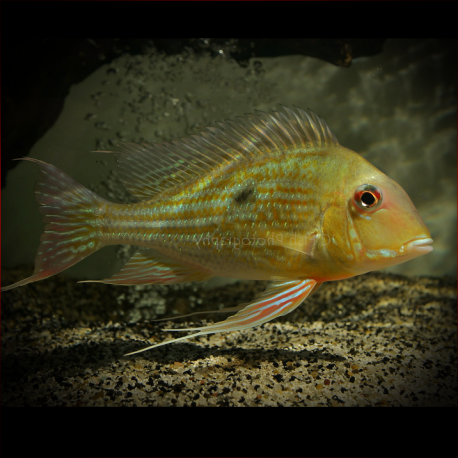More info
Datasheet
| Minimum Tank Size | 650 litres / 171.71 US gallons |
| Maximum Size | 20.0cm / 7.87inches |
| Temperature | 25°C / 77.00°F - 32°C / 89.60°F |
| Hardness | 1.01dgH / 18ppm - 10.03dgH / 179ppm |
| pH | 4.0-7.0 |
General Description
Geophagus Abalios is a commonly-traded member of the Cichlidae family, often misidentified as G. altifrons or G. surinamensis, with a maximum size of 20.0cm. It is part of the putative G. surinamensis 'group' of closely-related species in the suborder Perciformes. Geophagus Abalios is a substrate-spawning, biparental mouthbrooder, exhibiting fin flaring, circling, and head jerking displays during courtship.
Aquarium Setup
A suitable tank for Geophagus Abalios should include a soft, sandy substrate to mimic its natural foraging behavior. Coarse materials like gravel should be avoided. Dim lighting, driftwood, roots, branches, and flat rocks for spawning sites are recommended. Water quality is crucial, with over-filtration, weekly water changes of 50-70%, and careful mechanical filtration to prevent blockages. High flow rates should be avoided in the tank.
Behaviour
Geophagus Abalios is peaceful unless breeding, tends to exist in loose aggregations, and displays noticeable dominance hierarchy within a group. When kept in smaller numbers, weaker specimens may face excessive antagonism. It can be kept with various peaceful species but should be avoided with aggressive or territorial fish that require harder water.
Feeding and Diet
As benthophagous 'eartheaters,' Geophagus Abalios feeds by sifting substrate for edible items. Their diet includes small invertebrates, plant material, detritus, and sediment. In captivity, they should be fed a variety of high-quality prepared foods with a vegetable component and occasional live or frozen foods. Feeding small portions multiple times a day promotes natural browsing behavior.
Reproduction & Dimorphism
Geophagus Abalios is a substrate-spawning, ovophilous, biparental mouthbrooder with no discernible sexual dimorphism except during spawning when the female's ovipositor is visible. Courtship involves selecting and defending a spawning site, with the female holding the eggs. The male may become aggressive post-spawning, and both parents may care for the brood.
Habitat and Distribution
Geophagus Abalios is native to the Venezuelan Llanos, inhabiting lowland floodplain rivers with soft substrates, clear to black waters, and submerged vegetation. It occurs in various tributary systems of the Río Orinoco, with a distribution extending to the Río Casiquiare in Brazil. The species is found sympatrically with G. dicrozoster and other regional fishes in the aquarium trade.

